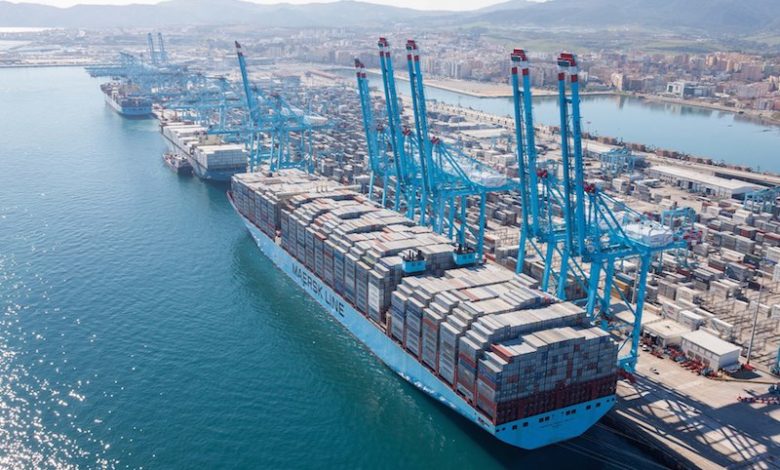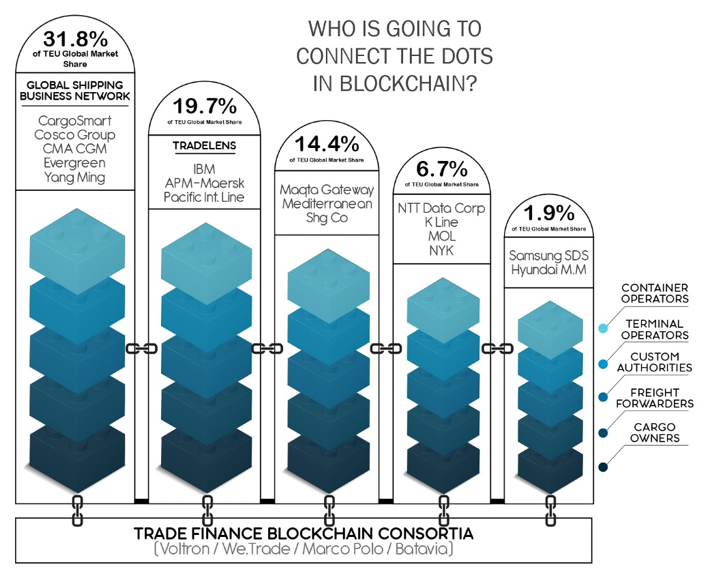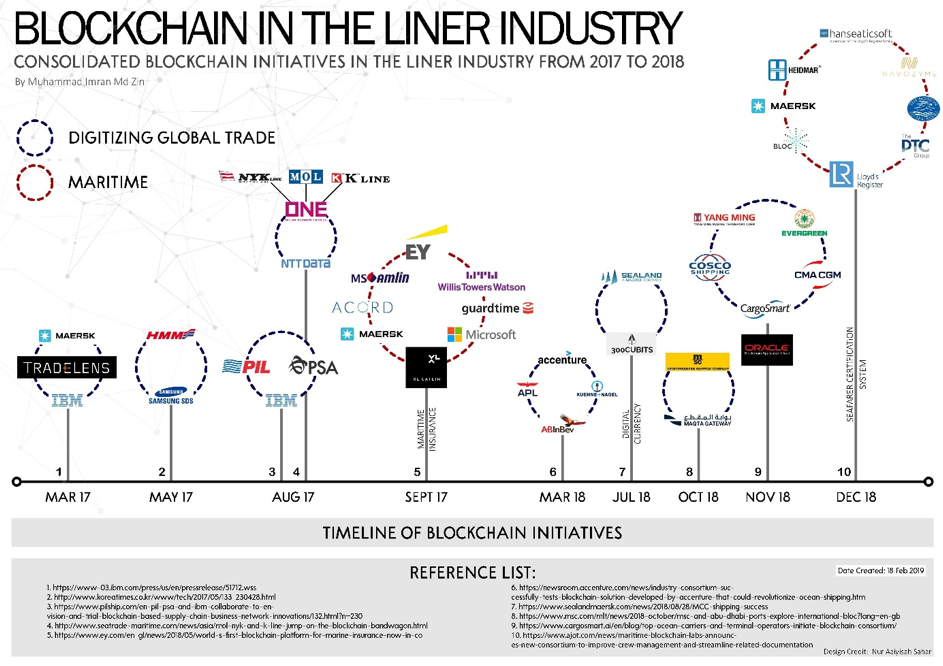Blockchain roaming in the maritime industry

How to get maritime blockchains to interact with each other. A special report compiled by Okan Duru and Muhammad Imran Md Zin.
There is no shadow of a doubt that the hottest topic of the maritime technology space is blockchain and how it is going to transform our commercial operations. In its ideal form, a blockchain platform is a distributed ledger which records transactions between parties in a verifiable and, most importantly, permanent way by using a cryptographic hash. When all major parties approve and implement a single blockchain system, then the entire commercial channel would be transformed into a super rapid, secure and totally digitalised environment. However, dreams do not come true especially when it smells like a monopoly of moderating such a massive and confidential digital network.
Since 2017, there have been various blockchain initiatives developed by liner shipping firms, and none of them has persuaded their major competitors to join their platform and consolidate the blockchain networks. Only Global Shipping Business Network (GSBN) was relatively successful on gathering four liner shipping firms in their platform (Oracle Blockchain with CargoSmart), but the proof of concept is not ready yet. In other words, none of the blockchain systems is welcomed as the industry standard of a legitimate monopoly in the network. Most probably, that will not be happening in the next decade (even longer). Then, the emergent question is how these liner shipping blockchains will communicate with each other and ensure the connectivity along the same line with mobile carriers or the internet.
Blockchain platforms today are more of a document digitalisation instrument instead of an ideal system as we mentioned above. In any case, a blockchain system may help to bypass various paperwork and customs operations which are significantly painful in undeveloped and developing countries. Even in a one-company-blockchain system, it has productivity gains and improved efficiencies for internal operations. While it is very convenient for the liner shipping firm, the disconnected blockchain space is a bit of a mess for users.
The idea of blockchain is initially expected to lift boundaries between transacting parties by offering a new way of authentication and digital ledger. When all parties agree and join one single blockchain initiative, all paperwork and transactions would be securely shifted to this new digital space. By utilizing the digital distributed ledger system, there would be no gap left to manipulations and counterfeit. The digital integration of all commercial transactions is a sort of consolidation, and in theory, all consolidations would improve economies of scale, productivity, efficiency and so on. The idea of central planning is not far different than the blockchain approach.
The problem with this theoretically excellent idea is the definition of a supreme and legitimate intermediary of fully connected blockchain initiative or the orchestrator of blockchains. As far as those blockchains cannot be connected and communicate properly, how can the industry reap the benefit of this revolutionising idea at the macro level? In the last few years, many carriers have invested in blockchain initiatives and collaborated with leading blockchain developers. Currently, there are six major blockchain initiatives that digitises global trade, which differs from their corresponding liner shipping alliances. For example, all carriers in 2M+H alliance have their own blockchain initiatives disconnected from their partners in the shipping alliance (i.e. Trade Lens, Maqta Gateway and Samsung SDS). Inconsistency between shipping alliances and blockchain initiatives will eventually cause posterior problems such as interoperability and disconnection. An average freight forwarder working with various carriers will need to connect with these disconnected blockchain initiatives in different standards and protocols. There is no dedicated connector for this blockchain network.
Contrarily, CargoSmart has pooled a significant number of carriers in its initiative, GSBN consisting of the Ocean Alliance members and Yang Ming Marine Transport Corp, and currently leads the blockchain space with over 30% market share (as per cargo volume). Out of the top 10 liner shipping firms, only Hapag-Lloyd has not released an announcement on developing a blockchain initiative in digitising global trade. However, since Yang Ming Marine Transport Corp – a member of THE Alliance has joined GSBN, it gives Hapag-Lloyd a justifiable reason to be a part of it.

The absence of a connector in the blockchain network is a growing problem, and no organisation has claimed the responsibility for this problem yet. In this circumstance, a political vacuum gains strength with the delay of such a connectivity platform and standardisation of blockchain data exchange protocols. Who is going to be the connector, the orchestrator of this network? Most importantly, the connector of this network must be an impartial and trustworthy institution which would be adopted as the supreme authority. So, the blockchain idea has initiated an institutional demand for interoperability and connectivity of many bounded initiatives.
There are international organizations such as World Trade Organization (WTO) or the United Nations Conference on Trade and Development (UNCTAD) which essentially promotes and deals with trade facilitation. WTO or UNCTAD may take a role on this gap. Classification societies have a long history of being adopted as trustable agents by governments and organisations. They may intervene in this growing deal. Blockchain may be an ignition point of discussions on legitimacy and standardisation of various digital initiatives. Electronic documents will also lead this kind of after-effects.
Following International Maritime Organisation (IMO) that has a long history in the safety and security of shipping, the concept on creating international shipping standards could be interchangeable and adopted by WTO or UNCTAD. By providing a forum where international standards can be discussed, created, agreed, adopted and implemented by member states could help facilitate the movement of digitalizing the global trade. Ultimately, all three could set a new beginning that will facilitate the development of blockchain. Blockchain may be an ignition point of discussions on legitimacy and standardization of various digital initiatives. Electronic documents will also lead this kind of after-effects.
The Blockchain roaming model
A viable solution to the problem is the roaming model of mobile network operators. However, the roaming model needs a standard data exchange protocol which is currently ignored in the blockchain space. Initial attempts to establish a de facto standard for the maritime blockchain space did not really work. Efforts on the de facto standard for enterprise blockchain need to evolve into an interoperable level. Almost all blockchain initiatives have their own unique data protocol which does not support interoperability. Aside from the technical inputs, gaps can also be found in areas of trade practices, customs procedures, legal jurisdiction and financial interest of differing countries. These gaps can be further categorised into critical focus points that need to be addressed such as organisational interoperability, legal interoperability, semantic interoperability and technical interoperability. Hence, the hinderance of interoperability is not within the technical level but consists of various factors along the line of movement of goods in the digital supply chain itself.
Because of this, a blockchain governance needs to be developed to create policies and standards that help to achieve interoperability. It can only be achieved with a cooperative standardisation among diverse initiatives and the governance of it is not governed by no one person, company, organisation or government. The big question is who is going to be the supreme orchestrator?
In 2019, it is expected that there will be new blockchain initiatives, but they are not concentrated in providing solutions to the inefficiencies of any industry. Instead, it will be a chain of initiatives that will connect the dots in blockchain to achieve interoperability. These initiatives will help to decentralise the network further into the macro level environment. However, an international body is required to direct these initiatives into a cooperative standardisation. Without it, the scalability of interoperability will not be at maximum. Recently, a group of digital leaders from Maersk, CMA CGM, Hapag-Lloyd, MSC and ONE started discussing the creation of common information technology standards.
In years to come, when these initiatives are realised and connected by cooperative standards, we can proudly say that blockchain has revolutionised the global trade by lowering the barriers of entry, expanding the pipeline of businesses and bringing new growth to the trade volumes leading to an increase in volume of goods transported and every stakeholders of the supply chain will profit from it.


Interesting article looking into real issues, but essentially missing a few things regarding the solutions:
– If you delegate the responsibility to a third-party, there’s no need for a BC.
– The solution here is to adopt an integration layer that orchestrates information based on consortium rules.
– Interoperability among protocols is in the roadmap of the 3 major available BC platforms (HLF, Quorum and Corda).
Glad to talk more about the topic (LinkedIn – Karen Czachorowski).
At the New York Hackathon, two weeks ago, a group of non shipping computer nerds came up with an idea from Healthcare, where there are numerous forms all having essentially same info fields but laid out and labelled differently.
Their suggestion is to use Artificial Intelligence to gather info, including unfilled fields (then flagged for followup) and then recompile the forms information so they match up. This is a different take on interoperabilty and reflecting the impossible of maritime folks ever agreeing on common standards.
https://www.businesswire.com/news/home/20190321005123/en/NYC-Maritime-Hackathon-2019-Connecting-Big-Data
Hi Barry. That seems a robotic process automation. A company in Singapore developed a front-end solution for users with no coding background. You can develop your own RPA loop with drag-and-drop interface.
https://www.robotics-process-automation.com/singapore/
I closely follow-up Chris and his team. Great things happen.
A good take on Blockchain from my good friend and colleague Okan Duru. The whole area of Blockchain cries out for greater transparency and connections of data. Our successful Hackathon provided several ideas in addition to the one Barry mentions in his post. The New York Maritime Innovation Center will serve as a connecting point for new developments in the maritech sector.
Hi Chris. Thanks for comments. It seems NYMIC creates new platforms and opportunities. Wish you and your team best at this great journey.
It is a good way to narrow the issue of connectivity and standards. One thing that needs to be called out explicitly is the identity management: in shipping we need to know our partners to avoid denied parties and undesirable locations. Such an identity management requires a neutral trusted party with a substantial expertise and resources to set it up – unlikely be done by a government organization, carrier or major IT vendor.
A Hackathon is a good way to tackle IT problems, yet in this particular case the issue of standardization (or lack off) in the industry runs deeper than what can be solved by a startup. Using AI for recognizing fields in the documents is a great idea for Bels and trade documentation but I doubt its applicability to solving the immediate connectivity issue.
Somebody who knows much more than I do on such subjects told me that you need to get all the data agreed before you can really press the connectivity. I still don’t see any force in the industry that will create the common standard, so a startup with “no bad habits” (read- “no ties to the industry”) could be the way to go- and get the data fields aligned. The common standard may be, in fact, an approach similar to that taken by the winning team at the Hackathon, which implicitly acknowledges that a bunch of shipping folks sitting in a room together will never agree on anything. Been there, done that….too many times. NYMIC has some legs- keep at it.
Hi Barry. You may also check this:
https://splash247.com/digital-container-shipping-association-launched-with-maersk-exec-installed-as-ceo/
………the Digital Container Shipping Association, a grouping that includes Maersk, MSC, Hapag-Lloyd and Ocean Network Express (ONE). Other lines are expected to join the association soon.
The association was first conceived in November last year and aims to focus on digitalisation, standardisation and interoperability….
Hi Barry. That is actually the main argument of this article. Common standard translates to a sort of monopoly which nobody would want to transfer.
“…Distributed digital ledgers can mitigate the mistrust that exists among transacting parties. Yet this same mistrust makes it hard to bring together diverse participants into a common blockchain ecosystem.”
You may find the original report here:
http://www.okanduru.com/Blockchain%20Roaming%20in%20the%20Maritime%20Industry.pdf
As you mentioned, this ecosystem needs an impartial intermediary to organize these things. So, our question is who will connect them? Why stakeholders will trust and transfer such authority to that intermediary at the cost of what?